Popular games published by company Williams Electronics
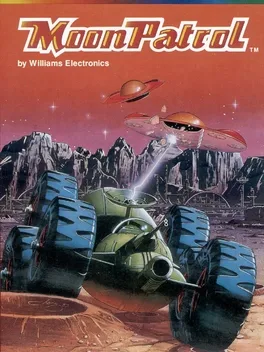
Moon Patrol is a side-scrolling shooter that puts players at the controls of a six-wheeled moon rover that can jump and shoot. The goal is to move through the entire course as quickly as possible while shooting enemies for additional points. Cannons are mounted on the front and top of the vehicle, and both fire simultaneously when the fire button is pressed. Rocks, mines, and pits in the course prevent you from just holding to the right for maximum speed. Rocks and mines can be shot, but pits must be jumped. Some enemies fire shots that create new pits in the course, forcing players to react quickly.
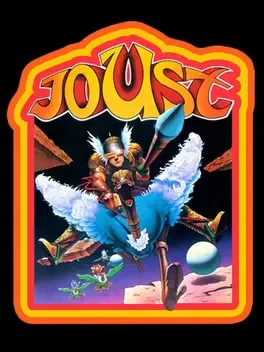
Joust is an arcade game developed by Williams Electronics and released in 1982. It is a platform game that features two-dimensional (2D) graphics. The player uses a button and joystick to control a knight riding a flying ostrich. The object is to progress through levels by defeating groups of enemy knights riding buzzards.

In 2084, man creates a species of super-advanced cyborgs known as Robotrons. Recognizing the imperfect nature of their creators, the Robotrons conclude that the inefficient human race must be exterminated. In Robotron: 2084, only you and a single family of clones remain. If mankind is to survive, you must destroy the Grunts, Brains, Enforcers, and Tanks - but avoid the indestructible Hulks at all cost. Can you withstand wave after wave of android invasion and rescue Mommy, Daddy, and Mikey... before it's too late?
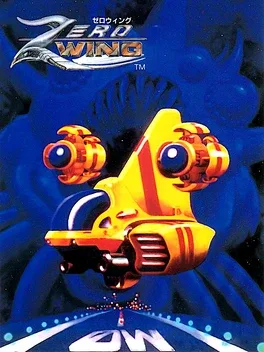
Zero Wing is a side-scrolling shoot 'em up arcade game, notable for a poorly translated English version for Sega Mega Drive (Genesis) that spawned the "All your base are belong to us" Internet meme. Gameplay includes novel features such as being able to 'tractor' enemy ships, using them to shield your own.
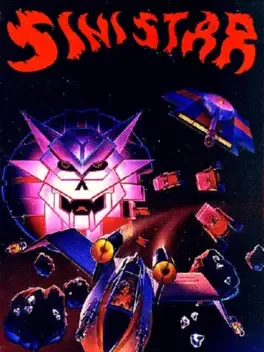
The player pilots a lone spacecraft, and must create "Sinibombs" by shooting at drifting planetoids and catching the crystals that are thereby released. Sinibombs are needed to defeat the game boss, Sinistar, an animated spacecraft with a demonic skull face. Sinistar does not exist at the start of the game, and is continuously under construction by enemy worker ships. Though time is crucial, attempting to mine too quickly will destroy a planetoid without releasing any crystals. Enemy worker ships are also gathering crystals (often stealing them from the player) which they use to construct the Sinistar. Enemy warrior ships can directly attack the player's ship. The player is given a head-start before the enemy ships have enough crystals to begin construction. Game ends when the player's ships are all destroyed. Once the Sinistar is completely formed, a digitized voice makes various threatening pronouncements, including "Beware, I live!," "I hunger, coward!," "I am Sinistar!," "Run! Run! Run!," "Beware, coward!", "I hunger!," "Run, coward!," and a loud roaring sound. The Sinistar has no weapon attacks, but if it contacts the player's ship while it darts about the playfield, the player's ship will be "eaten" and destroyed. A total of 13 Sinibombs are required to destroy a fully built Sinistar, although an incomplete Sinistar can be damaged to slow construction. Each short-range Sinibomb automatically targets the Sinistar when fired, but can be intercepted by a collision with an enemy ship, enemy fire, or a planetoid. The player moves from one zone to the next each time he defeats the Sinistar. A sequence of four zones repeats continuously after the first zone. Each is named for the most numerous feature of that zone: Worker Zone, Warrior Zone, Planetoid Zone, and Void Zone (the Void Zone is especially difficult because it has very few planetoids). Beginning with the first Worker Zone, a completed but damaged Sinistar can be repaired/rebuilt by the enemy ships by gathering more crystals, extending its "lifespan" if the player is unable to kill it quickly.

Defender is an arcade video game developed released by Williams Electronics in 1980. A shooting game featuring two-dimensional (2D) graphics, the game is set on a fictional planet where the player must defeat waves of invading aliens while protecting astronauts. Development was led by Eugene Jarvis, a pinball programmer at Williams; Defender was Jarvis's first video game project, and drew inspiration from Space Invaders and Asteroids. Williams planned to display the game at the Amusement & Music Operators Association (AMOA) trade show, though development delays resulted in the team working on the game up until the show started. Defender was commercially successful, selling over 55,000 units to become the company's best selling arcade game. Praise among critics focused on the game's audio-visuals and gameplay. It is frequently listed as one of Jarvis's best contributions to the video game industry, as well as one of the most difficult video games. Defender was ported to numerous platforms, inspired the development of other games, and was followed by sequels and many imitations.
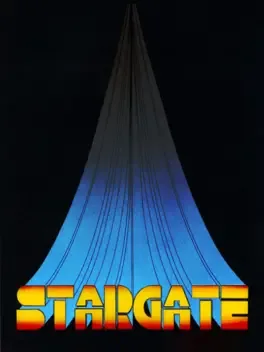
Arcade shooter where you protect humans from being captured by aliens. Created by Eugene Jarvis and Larry DeMar, it is a sequel to Defender which was released earlier in the year. Some home ports of Stargate were renamed to Defender II for legal reasons.
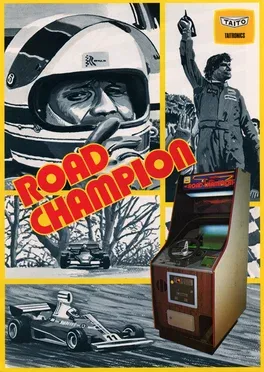
An arcade racing game from Taito.
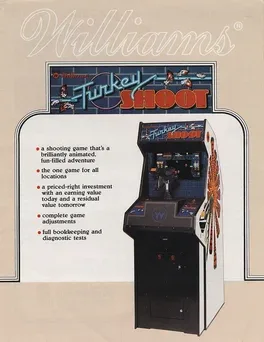
Shoot 'em up
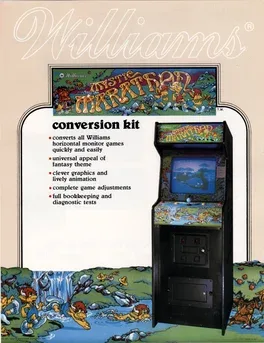
The game is a left-to-right footrace between the player-controlled creature and six controlled by the computer. Each island contains multiple paths, and the creatures have to swim the water between the islands, which is slower than running. Many obstacles slow the creatures down, including apple-throwing trees, lightning, sea monsters, giant clams, and sinkholes. There are also ways to move forward quickly, such as a hand that throws a character and caves that warp the creature to the exit. In addition to a joystick for movement, there is a jump button. The goal is to finish in the top three to progress to the next race.
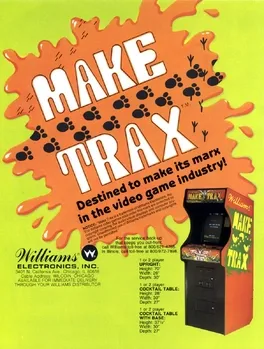
Player controls a paintbrush to paint paths within a maze. The player is harassed by two fish which can be temporarily destroyed by running them over with a one of two paint rollers located near the maze center. A critter occasionally emerges to leave footprints on painted areas which must then be repainted.
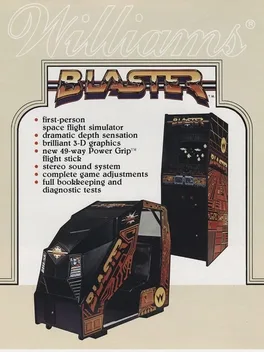
The year is 2085 and the Robotrons have destroyed the human race. You escape in a stolen space shuttle. Your destination: Paradise. A remote outpost 20 million light years away. Does paradise exist? Can civilization be started again? These questions will be answered at the end of your journey. But first, you must BLAST... OR BE BLASTED!
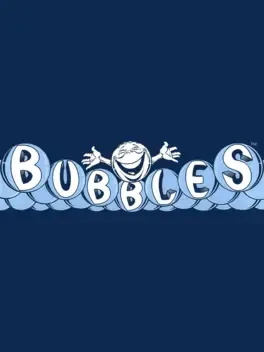
Bubbles is an action game with puzzle elements where the player controls the protagonist, a soap bubble, from a top-down perspective. The object is to clean a kitchen sink by maneuvering the bubble over ants, crumbs, and grease to absorb them. The bubble will grow larger the more objects it absorbs. The player is impeded by enemies—brushes, razor blades, roaches, and sponges—that are deadly to the character. Except for razors, enemies also compete with the player to absorb objects in the sink. Once the bubble reaches a certain size, it will acquire a smiling face and become invulnerable against brushes and sponges; contact with those will reduce the bubble's size to the point it becomes vulnerable again. After all the objects are gone, the player will progress to the next level if the bubble is large enough. If the bubble is not large enough at that point, or if the player enters the drain while the bubble's too small, a life is lost. Once the bubble becomes large enough, the drain in the center of the sink will begin to flash green, signaling the player to enter it to progress to the next level.
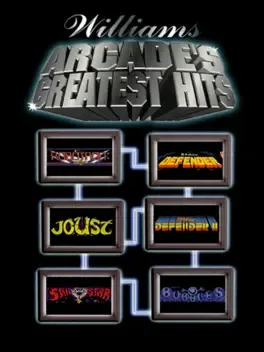
Williams Arcade's Greatest Hits for PlayStation and Sega Saturn is a compilation of the Arcade games: Robotron: 2084, Joust, Sinistar, Defender, Defender II and Bubbles. Also included are video interviews with the original developers. The Sega Saturn release was published by Midway Home Entertainment and retitled to Midway Presents Arcade's Greatest Hits. It was also released for Super Nintendo Entertainment System and Sega Mega Drive/Genesis but without Bubbles and the video interviews.
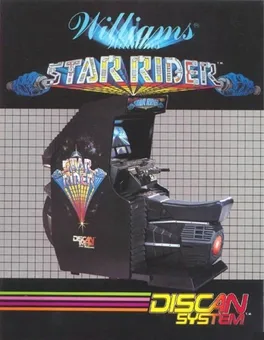
Star Rider is a futuristic motorcycle racing game that used pre-rendered 3D graphics stored on LaserDisc.
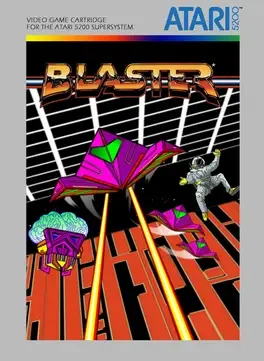
Blaster developed by Vid Kidz for Williams was released for the arcades and is quite obscure. What is interesting however is that the Atari 5200 version that was not released was actually made before the arcade game. An unofficial sequel to Robotron 2084 (As it takes place in 2085) Blaster is a 3d style shooter with impressive graphics for the time. In it the player takes the view from a spaceship cockpit so moving in the different directions shifts the entire screen. There are four levels you will play through avoiding obstacles, saving humans, and defeating alien enemies. Upon beating the four levels the game loops but will be more difficult.